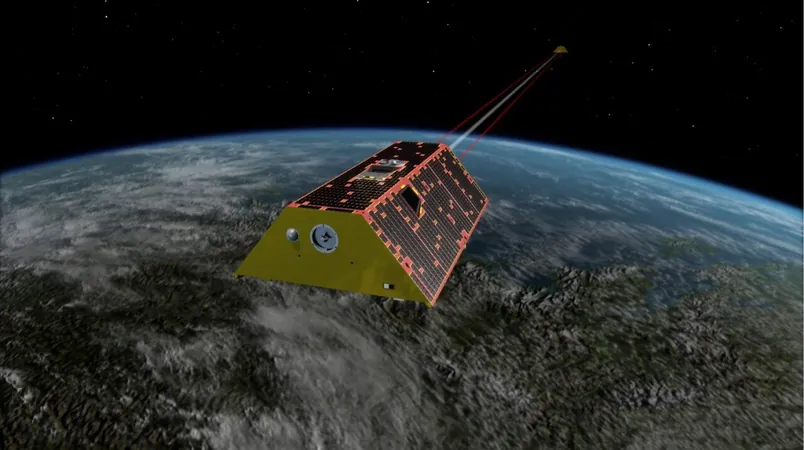
NASA Satellites Uncover Alarming Drop in Global Freshwater Levels — What It Means for Our Future
2024-11-15
Author: Jia
Introduction
In a groundbreaking study published in *Surveys in Geophysics*, an international team of scientists has revealed a startling decline in the Earth’s freshwater levels, using advanced observations from NASA-German satellites. This plunge began in May 2014 and has persisted at dangerously low levels ever since, indicating that our planet's continents may be entering an unusually arid phase.
Satellite Data and Findings
From 2015 to 2023, data from satellite measurements indicate that the average volume of freshwater stored on land—encompassing lakes, rivers, and groundwater—has decreased by a staggering 290 cubic miles (1,200 cubic kilometers) compared to levels recorded between 2002 and 2014. To put this into perspective, this loss is equivalent to more than twice the volume of Lake Erie, one of the Great Lakes in North America.
Impact of Drought and Groundwater Reliance
Drought conditions, combined with the modern demand for irrigated agriculture, have pushed both farms and urban areas to increasingly rely on groundwater. This reliance triggers a harmful cycle: as freshwater supplies dwindle, the inability of rain and snow to replenish these sources leads to increased pumping of groundwater, further exacerbating the depletion of underground reserves.
Consequences of the Freshwater Crisis
The ramifications of this freshwater crisis are dire. According to a United Nations report on water stress released in 2024, dwindling water supplies could lead to severe consequences: famines, rising conflicts over dwindling resources, increased poverty rates, and a heightened risk of disease stemming from reliance on contaminated water sources.
Data Collection and Methodology
The research team identified this alarming decrease in global freshwater using data from the Gravity Recovery and Climate Experiment (GRACE) satellites. These satellites, a collaborative effort among the German Aerospace Center and NASA, track fluctuations in Earth’s gravity, which provide insights into changes in the mass of water both on and beneath the surface. The original GRACE satellites were operational from March 2002 to October 2017, with their successors, the GRACE–Follow On (GRACE–FO) satellites, launching in May 2018.
Global Drought Correlation
The dramatic decline in global freshwater correlates with a widespread drought that struck northern and central Brazil, followed closely by severe droughts across Australasia, South America, North America, Europe, and Africa. An intense El Niño event from late 2014 to early 2016, the strongest since 1950, significantly altered global weather patterns, triggering these droughts.
The Role of Global Warming
Despite expectations that freshwater levels might recover post-El Niño, the situation has continued to deteriorate. Researchers assert that since January 2015, 13 of the 30 most extreme droughts recorded by GRACE have occurred. Matthew Rodell, a hydrologist at NASA's Goddard Space Flight Center, hypothesizes that global warming may be a driving force behind this persistent freshwater depletion.
Changing Precipitation Patterns
As the atmosphere holds more water vapor due to global warming, the frequency and intensity of extreme precipitation events have surged. While total rainfall may not show drastic yearly changes, the prolonged intervals between significant rain lead to soil desiccation and compaction, reducing the land's capacity to absorb water. “When extreme precipitation occurs, the water often runs off instead of replenishing groundwater supplies,” warns NASA Goddard meteorologist Michael Bosilovich.
Future Implications and Questions
Given that the nine warmest years on record align with this freshwater decline, researchers are increasingly cautious. "We don’t think this is a coincidence; this could very well be a sign of what lies ahead for our planet,” Rodell cautions.
Conclusion
The big question remains: Will global freshwater levels return to pre-2015 values, stabilize, or continue their downward trajectory? The urgency of understanding this environmental crisis could not be more pronounced, as teams around the globe scramble to address these alarming trends and their potential impacts on food security, public health, and international stability.
Stay tuned for further updates on this critical issue—our planet’s water future may depend on it!




 Brasil (PT)
Brasil (PT)
 Canada (EN)
Canada (EN)
 Chile (ES)
Chile (ES)
 España (ES)
España (ES)
 France (FR)
France (FR)
 Hong Kong (EN)
Hong Kong (EN)
 Italia (IT)
Italia (IT)
 日本 (JA)
日本 (JA)
 Magyarország (HU)
Magyarország (HU)
 Norge (NO)
Norge (NO)
 Polska (PL)
Polska (PL)
 Schweiz (DE)
Schweiz (DE)
 Singapore (EN)
Singapore (EN)
 Sverige (SV)
Sverige (SV)
 Suomi (FI)
Suomi (FI)
 Türkiye (TR)
Türkiye (TR)